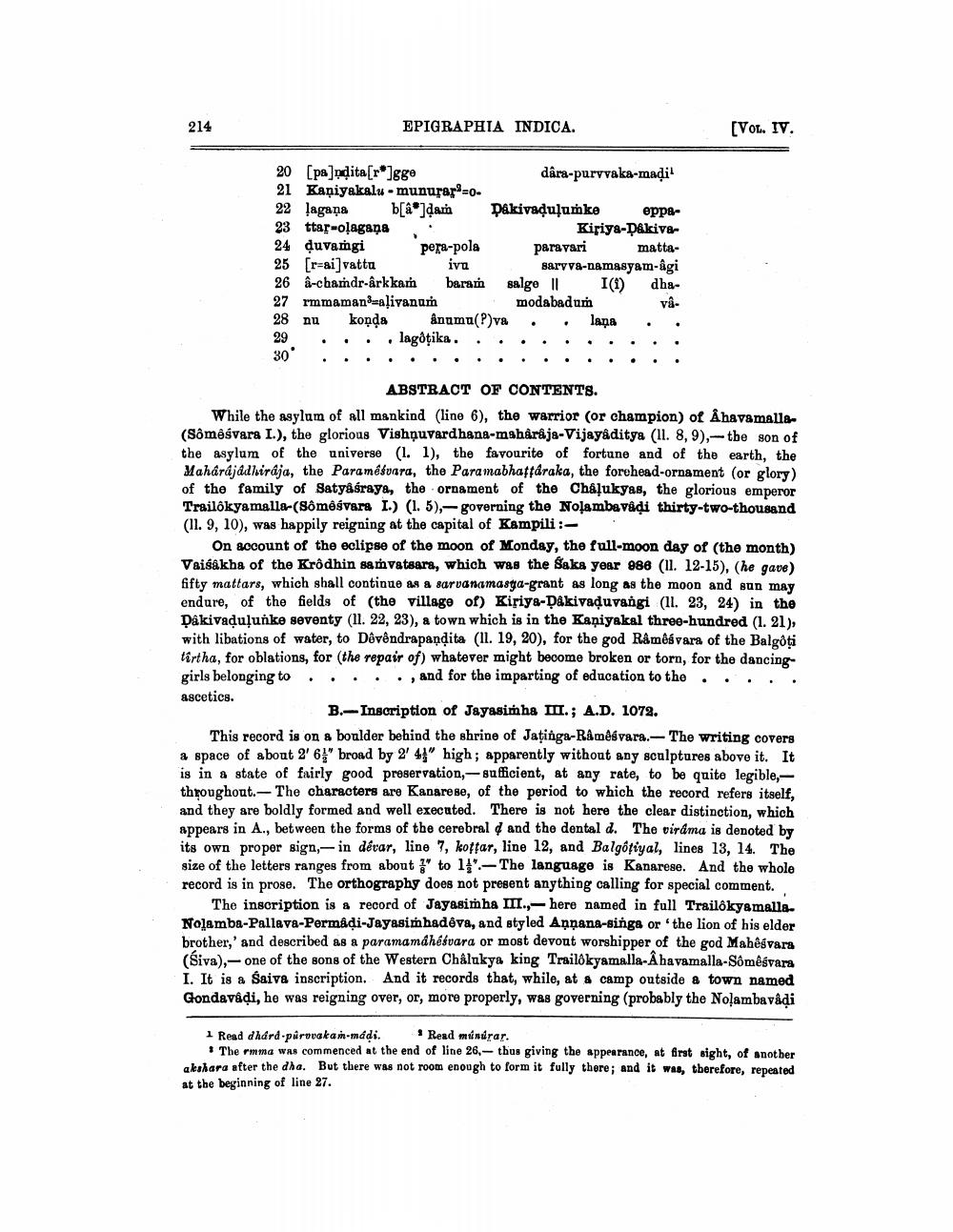________________
214
EPIGRAPHIA INDICA.
[VOL. IV.
20 (pandita[r]gge
dâra-purvvaka-madi! 21 Kaniyakalu - munurar-o22 lagana b[a ]dam Dakivaduļurke eppe23 ttar-oļagana .
Kiriya-Dikive24 duvamgi pera-pola paravari matta25 [r=ai]vatta
iva
sary va-namasyam-agi 26 â-chandr-arkkan baram salge 111 (1) dhs27 rmmamand=alivanıṁ
modabadum
vâ. 28 nu konda anuma(?)va . lana . . 29
lagðţika . . . . . . . . . . .
ABSTRACT OF CONTENTS. While the Agylum of all mankind (line 6), the warrior (or champion) of Åhavamalla(Sômêsvara I.), the glorious Vishnuvardhana-maharaja-Vijayaditya (II. 8,9), the son of the asylum of the universe (1. 1), the favourite of fortune and of the earth, the Maharajadhiraja, the Paramešvara, the Paramabhaftáraka, the forehead-ornament (or glory) of the family of Satyåśraya, the ornament of the Châļukyas, the glorious emperor Trailokyamalla-(Sômêśvara L.) (1. 5),- governing the Nolambavadi thirty-two-thousand (11. 9, 10), was happily reigning at the capital of Kampili:- .
On account of the eclipse of the moon of Monday, the full-moon day of (the month) Vaisakha of the Krôdhin samvatsara, which was the Saka year 988 (11. 12-15), (he gave) fifty mattars, which shall continue as a sarvanamasya-grant as long as the moon and sun may endure, of the fields of the village of) Kiriya-Dakivaduvangi (1l. 23, 24) in the Dâkivadulunke seventy (11. 22, 23), a town which is in the Kaniyakal three-hundred (1.21), with libations of water, to Dévândrapandita (11. 19, 20), for the god Råmēs vara of the Balgoti tirtha, for oblations, for the repair of) whatever might become broken or torn, for the dancinggirls belonging to .. . . ., and for the imparting of education to the . . . . . ascetics.
B.- Inscription of Jayasimha III.; A.D. 1072. This record is on a boulder behind the shrine of Jaținga-Ramêsvara. - The writing covers a space of about 2'6" broad by 2' 4" high; apparently without any sculptures above it. It is in a state of fairly good preservation,-sufficient, at any rate, to be quite legible, throughout. - The characters are Kanarese, of the period to which the record refers itself, and they are boldly formed and well executed. There is not here the clear distinction, which appears in A., between the forms of the cerebral and the dental d. The viráma is denoted by its own proper sign,-in dévar, line 7, kotfar, line 12, and Balgêtiyal, lines 13, 14. The size of the letters ranges from about to lik-The language is Kanarese. And the whole record is in prose. The orthography does not present anything calling for special comment.
The inscription is a record of Jayasimha III.,-here named in full Trailôkyamalla. Nolamba-Pallava-Permadi-Jayasimhadeva, and styled Annana-sings or the lion of his elder brother,' and described as a paramamáhésvara or most devout worshipper of the god Mahêśvara (Śiva),- one of the sons of the Western Châlukya king Trailokyamalla-Ahavamalla-Sômêsvara I. It is a Saiva inscription. And it records that, while, at a camp outside a town named Gondavâļi, he was reigning over, or, more properly, was governing (probably the Noļambavadi
Read dhárd pårsvakan-madi. Read mindrar.
+ The rmma was commenced at the end of line 26.- thus giving the appearance, at first sight, of another akshara after the dha. But there was not room enough to form it fully there, and it was, therefore, repeated at the beginning of line 27.




